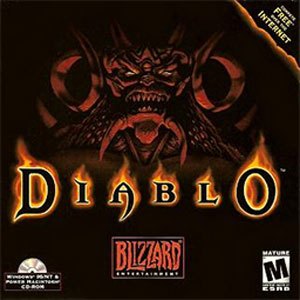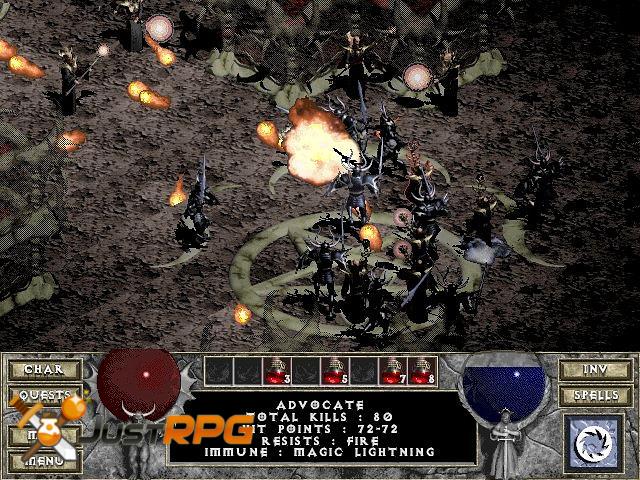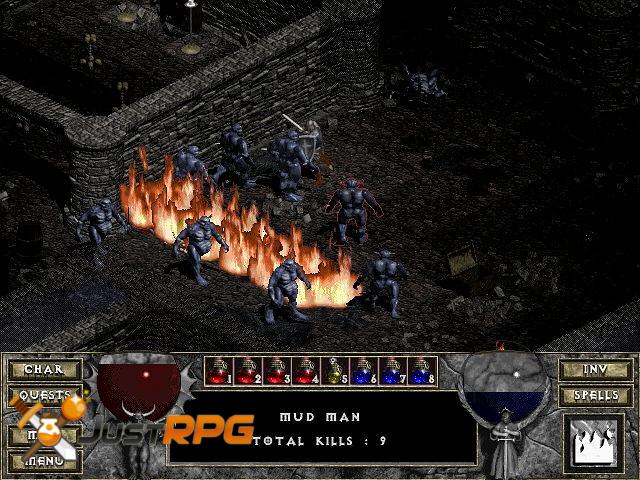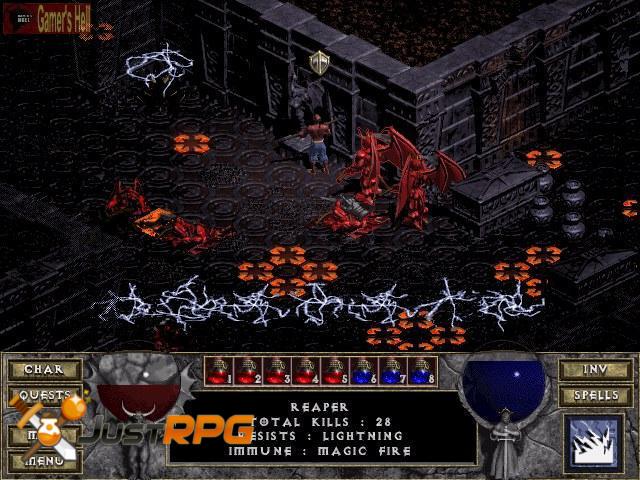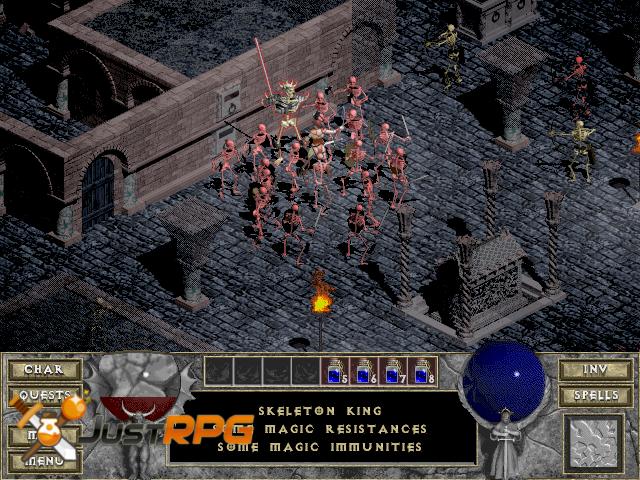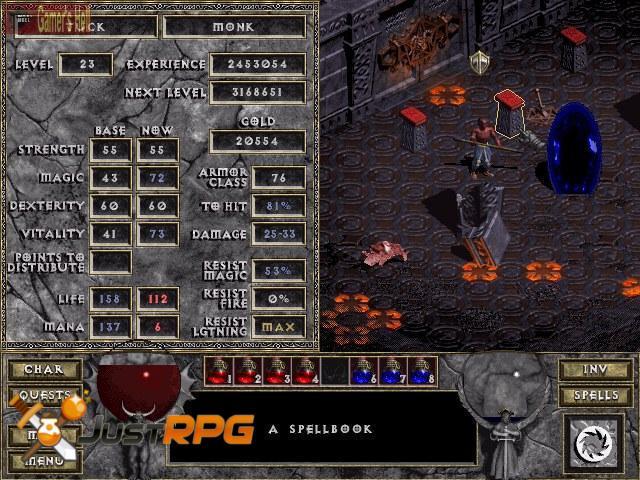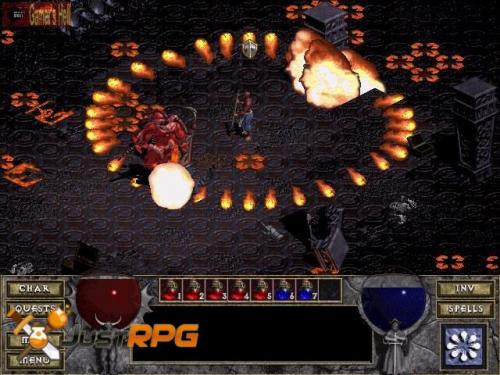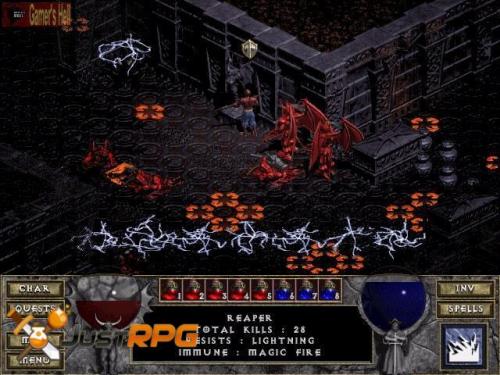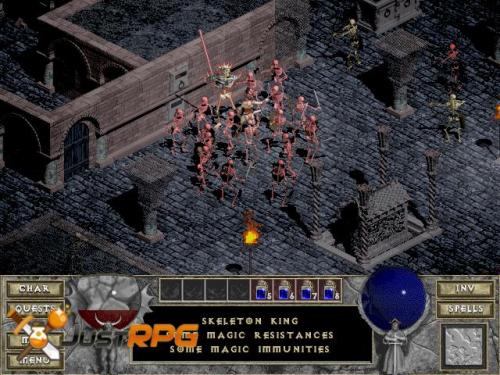Diablo
Diablo is an action RPG set in the blighted city of Tristram. Play as a Warrior, Rogue, or Sorcerer and eradicate the demons haunting the land. Diablo has fast paced gameplay, an interesting story, and plenty of loot waiting to be acquired. While simple to play, Diablo can be enjoyed for many hours and multiple replays.
| Developer: Blizzard Entertainment Publisher: Blizzard Entertainment Release Date: November 30, 1996 Platform: PC JustRPG Score: 98% Pros: +Simple yet addictive gameplay. +Great setting and production value. +Varied equipment and other loot to amass. Cons: -Simple combat mechanics that can get repetitive. -No puzzles, mazes, minigames, or other diversions. Just hack and slash. |
Diablo Overview
Diablo is a genre defining title first released in 1996. The simple hack and slash gameplay combined with the random loot system proved to be an addictive combination that kept gamers coming back for more. The story is set in Tristram which is under siege by Diablo, the Lord of Terror, and his demon minions. Players select from three character classes: the Warrior, Sorcerer, or Rogue and must clear out the nearly endless waves of baddies. Diablo found a large following online where multiple players could team up, chat, and trade items. The success of Diablo lead to a the launch of a series which includes Diablo 2, Diablo 2: Lord of Destruction, and Diablo 3.
Diablo Screenshots
Diablo Featured Video
[youtube]http://www.youtube.com/watch?v=prvzzIa8qzY[/youtube]
Diablo Review
By, Nimish Dubey
If one has a taste for cowboy westerns, one could probably classify RPGs into the good, the bad and the ugly. And if one had played Diablo, there would be a sore temptation to add ‘the great’ to those categories. Six years, a couple of expansions and a full-fledged sequel have only added to its stature. In fact, one could get so bold as to say that the gaming world should be divided into two sections – those who have played Diablo and those who have been daft enough to give it a miss. Needless to say, I belong to the former.
What is most impressive about Diablo is its simplicity. You are the hero (or heroine) and your job is to kill the bad guys (and girls). The narrative is superb, the movement is smooth and there are no complicated keystrokes – in fact, if you are adept at using the mouse, you can safely unplug your keyboard.
The game’s story revolves around the town of Tristram. Once a happy and bustling place, it is now a shadow of itself, thanks to the powers of darkness, led by no other than Diablo, the lord of terror. The King has been cursed, his son kidnapped and several citizens of the town slaughtered. All that is left in the town is a drunk, a blacksmith, a village elder, a witch, a healer, a tavern keeper, a barmaid and a one-legged boy who deals in smuggled arms (much to the annoyance of the blacksmith).
The root of all evil is the cathedral to the north of the town. It has been desecrated by demons and it is now up to you to descend into its dungeons, kill Diablo and his minions and save the day.
It is the little subtleties woven around this basically simple tale that make Diablo such a compelling game. To begin, there are three characters to choose from – the warrior, the rogue and the sorcerer. Each character has its own strong points and weaknesses. To wit, the warrior is terrific at man-to-man combat but can get clobbered against an opponent who fights from a distance; the rogue is handy at battle from a distance but is vulnerable closer-up; and the sorcerer can cast spells that spell doom for the enemy but is appalling when it comes to traditional warfare. All three can use weapons as well as magic. The catch – of course, there is one – being that none of the characters is equally adept at both. The warrior can wield the heaviest weapons and don massive armour, the rogue can wreak havoc with a bow and the sorcerer is at his best when using a magical staff or spells.
One can regulate the abilities of one’s character by allotting points to four different characteristics – strength, dexterity, magic and vitality. Every time your character moves up a level – which happens after you have slaughtered the requisite number of bad fellas to notch up the required points – you get an opportunity to divide five additional points among your characteristics. This does bring in the need for a certain amount of planning. Should one attempt to boost the core strength of a character or attend to his or her Achilles heel?
Then there are the missions. In the beginning, most of the missions will be given by people of the town. These could be as formidable as fighting the demented King Leoric or as trivial as finding the missing signboard of the local tavern. As you progress further, you will stumble across missions in the dungeons themselves with old books telling you what needs to be done. Each successful mission gets you a special reward.
Adding a spin to it all is the fact that the missions you get are selected at random. In other words, you may get a different combination of missions each time you play a new game. Even the kinds of monsters, weapons and armour that you get are different. Diablo also randomly generates every level of the dungeons, including the rooms, hallways, lights, shrines, fountains, cauldrons, pools, special themed areas, treasures and monsters. All that is certain is that at the end, you will have to deal with Diablo. If that does not make for phenomenal replay value, I don’t know what does.
The dungeons could have been the game’s weakness – after all, most of the character’s time is spent there and surely one can get bored with level after level of them. But this is where the game excels. The dungeons are very well designed and in fact change in complexion after every few levels – giving way to catacombs and caves, and towards the end your character actually ends up fighting in hell with spooky looking staircases and carcasses strewn around. Alleviating the tedium are books that tell you about Diablo and his demons, and several shrines that benefit or damage your character, depending on his/her fortune.
Prowling these dungeons is a whole cornucopia of monsters – all sorts of skeletons, Burning Dead, Carvers, members of the Goat Clan, bats, scavengers and lots more. Although most of the creatures can be beaten easily with the right weapon, there are a few who have special abilities and take some beating. There is a bright side to slaughtering these VIPs – killing them often yields special weapons, gems, armour, magic staves and the like.
Combat itself is, you guessed it, rather simple. To use a weapon, all you have to do is click on your enemy to inflict a blow on him, her or it. Of course, if you are the type that likes to throw the odd magical spell, just make sure you select it first. Do not look for subtle weapon movements on the lines of Die By the Sword – all you can do here is click on the enemy and hope that your character will deliver the blow that matters.
Which brings us to the armoury at the disposal of your character. Diablo serves up quite a handful. There are a variety of swords, shields, bows, axes, magical staffs, armours, helmets, magic scrolls and so on. And if your character has the requisite strength or dexterity, he or she can wield any of them. The weapons can be purchased from the ironsmith, while the healer and the witch deal out the magical stuff. Topping off the arsenal is a whole variety of stuff that is found in the dungeons.
I played the game to a finish in all three characters and had the most fun playing as the sorcerer. Mind you, it is also the most difficult character as many of the creatures in the dungeons are immune to certain spells. So if a sorcerer is surrounded by an assortment of monsters, he has to keep switching spells and hope for the best. The rogue too can get into trouble if she is surrounded as her forte is fighting from a distance. The warrior has it the easiest – after all, good old cold steel hurts every one! But even he has to sweat through quite a few levels before triumphing against all odds.
The game’s graphics were considered revolutionary when it was launched and are still as beautiful as ever. The dungeons are intricately designed, the characters look good and the combat is thrilling to watch. The entire game is played in an aura of darkness that seems to justify the seriousness of the mission. After all, tangling with the forces of darkness is not exactly a joyride. And accompanying you on your mission is some truly stunning music. The guitar chords that echo in the town of Tristram will surely remind music lovers of the beginning of ‘Hotel California’. And the rumble of drums that accompanies your character into each level of the dungeons is good enough to send a chill down your spine. The voice acting is superb with plenty of meaningful monologues. Unfortunately, your character’s role is restricted to listening, although you do have the power to choose the subject under discussion.
This does not mean that Diablo is perfect. No, there are times when the relentless killing grates on your nerves. In the end, it all seems to boil down to how many times you hit the other enemy without letting them get a stab at you. Many times it is difficult to tell what affect a shrine has on a character – all one sees is a mystic-sounding sentence on the lines of ‘strength is forged through destruction’. Similarly, if you happen to be a sorcerer, you do not really know whether your spells will have any effect on the demons you are fighting until you actually try them out – a rather risky approach. There are no puzzles to solve, no negotiations to be made – in short, this is not exactly a game for those seeking intellectual stimulation. The only time you have to think is when you choose weapons or spells or allot points to different features of your character. And then there is the ending. While I will not give away the plot, the fact remains that the end of the game was designed to accommodate a sequel – not very noble!
For all that, it is difficult to deny that Diablo is perhaps among the most addictive RPGs ever made. I have yet to meet a person who has not played the game for hours on end after starting it. There are those who claim that Diablo is nothing but a violent game that panders to mankind’s baser instincts. All I can say is that it transports you to another time and another land, asks you to fight evil and makes it all utterly engrossing. All this without asking for high system requirements, whether PC or Mac.
I rest my case.
Final Grade: 98%
Review Date: September 11, 2002
Diablo Screenshots
Diablo Videos
Diablo Intro Cinematic
[youtube]http://www.youtube.com/watch?v=prvzzIa8qzY[/youtube]

